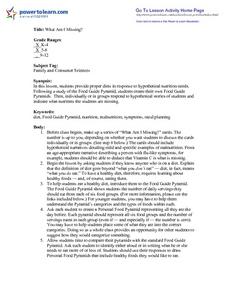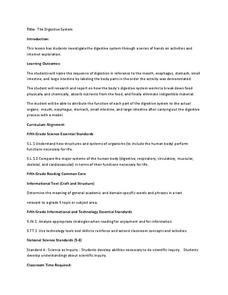Curated OER
Nutrients Nutrients We Need
Second graders examine the six nutrients humans need to maintain good heath. In this ecosystem lesson, 2nd graders learn about how plants grow and compare how humans need nutrients from plants to how plants need nutrients from the soil....
Polar Trec
Bering Sea Fabulous Food Chain Game
In spring, the Bering Sea turns green due to phytoplankton, which live at the surface, experiencing a population explosion. Groups of scholars play a food chain game, writing down food chains as the game is played. After five to six...
Curated OER
Benefits of Nutrients
Explore the nutrients a body needs using this resource. Learners discuss the importance of the relationships between proteins, fats, carbohydrates, vitamins, minerals, and water. It's a great way to have your class talk about the healthy...
Curated OER
Food chains and webs
Here is an extremely simplistic look at food chains and webs. It depicts three different food chains, each containing a plant, plant eater, and meat-eater. Learners fill in the missing part of each chain by using the images provided at...
Curated OER
Food Pyramid
Students construct food pyramids by painting shoe boxes and using them to respresent different food groups. They cut out and paste pictures of the respresentative foods for the groups on the box sides. They compare their diets to the...
Curated OER
Great Lakes Food Web
Students identify species and components of a Great Lakes food web. Using note cards, they place themselves in the correct order of the food chain based on the species present. They discuss what they believe happens to various species...
Curated OER
What Am I Missing?
Discuss nutrition and identify components of a healthy diet, view a Food Guide Pyramid, and create a Personal Food Pyramid, listing all foods eaten in the past 24 hours. Compare food lists with the standard Food Guide and determine where...
Curated OER
Nutrients
Fourth graders understand the important nutrients in food and the value of each. In this nutrients lesson, 4th graders complete a chart giving examples of foods that contain that nutrient and a definition of the nutrient. Students...
Curated OER
4th Grade Food Safety Lesson
From a high-speed hand-washing lesson to identifying important nutrients in fruits and veggies, this resource has several activity ideas and worksheets for teaching food safety to your learners.
CCEA
Home Economics: Teen Building
Learners explore the emotional and nutritional needs of teenagers in a six-lesson unit, which covers such topics as food sources, cooking skills, emotional well-being, and the positive effect of food and family occasions.
Curated OER
Food for Thought
Fifth graders explore the brain and what is needs. In this biology lesson plan, 5th graders will work on a series of activities that will allow them to learn about the brain, its parts, and the best foods to eat for their brain.
Curated OER
Dietary Guidelines/Food Pyramid
Students study the recommended Dietary Guidelines for Americans and the Food Guide Pyramid. They discuss the foods they eat, watch a video about the Food Pyramid and examine actual foods portioned out into recommended serving sizes.
Curated OER
Nutrients
Fourth graders discuss whether they ate breakfast and if so, did their breakfast contain all that their body needs until lunch time. They talk about the definition of nutrients and that every part of their body needs water. They also...
Curated OER
The Six Nutrients Student Worksheet
In this health worksheet, students answer ten questions based around the concept of the different types of foods like carbohydrates, proteins, and fats with an emphasis upon how they are used in the body.
Curated OER
Go With the Energy Flow
Learners explore energy and nutrient flow. In this science instructional activity, students diagram the flow of energy through food chains and food webs. Learners discuss the importance of energy flow in Earth's ecosystems.
University of Texas
What Are Calories?
What are calories, and how do calorie needs differ from person to person? Here is a worksheet that briefly explains how calories measure the energy supplied by food, as well as suggests the amount of food an individual should eat per day.
Curated OER
Building a Better Body
Fourth graders investigate the six essential nutrients. They read a handout, discuss the six nutrients, and construct a sandwich using ingredients that belong to the nutrient groups.
Curated OER
Meal Planning
Students study the nutrients found in foods and the food pyramid. In this investigative lesson students will plan a seven day menu built around the food pyramid.
Curated OER
You Are What You Eat (The 6 Main Nutrients Found in Foods)
Students study how carbohydrates, proteins, fats, vitamins, minerals and water provide basic nutrients for body growth and function. They describe quality sources of the basic nutrients and the importance of water.
Curated OER
A Healthy Diet is a Balancing Act
It's important to teach kids how to have a balanced diet. They are provided with six different meals, they fill in the blanks to complete each one to make it balanced. The answers could be anything and the meals offered don't seem very...
Curated OER
The Digestive System
Discover how the human body's digestive system works with a brain and stomach friendly activity. Scholars taste test a variety of foods to find out how they behave once in the mouth. Class members then play a game called Move That...
Curated OER
Foods and Nutrition
Students study nutrition, healthy choices for food, and ways to prepare food. They review the Food Guide Pyramid and play Nutriend Tic Tac Know to select healthy foods. As a group they make pretzels, Mystery Muffins, soda, and play the...
Curated OER
Nutrition
Seventh graders investigate nutrition and nutrients. In this nutrition or diet lesson plan, groups of students create a poster, commercial, or skit about a nutriet which will be presented or performed to the rest of the class...
Curated OER
Ocean World
In this components of the ocean worksheet, students answer 20 questions about various species in the ocean such as plankton, different types of whales, sharks, and herring. Students also answer questions about the volume of water in the...























